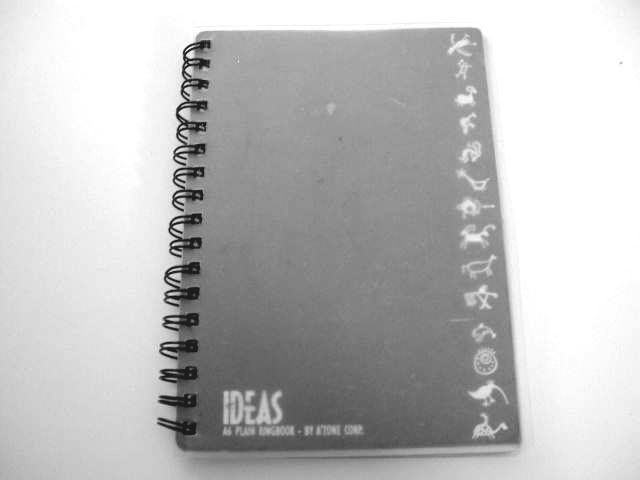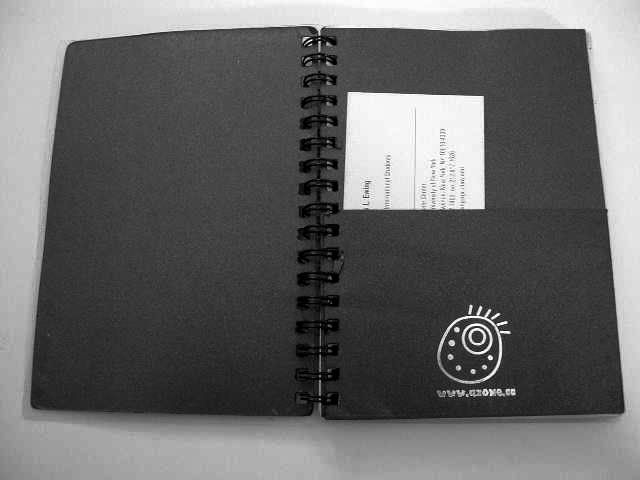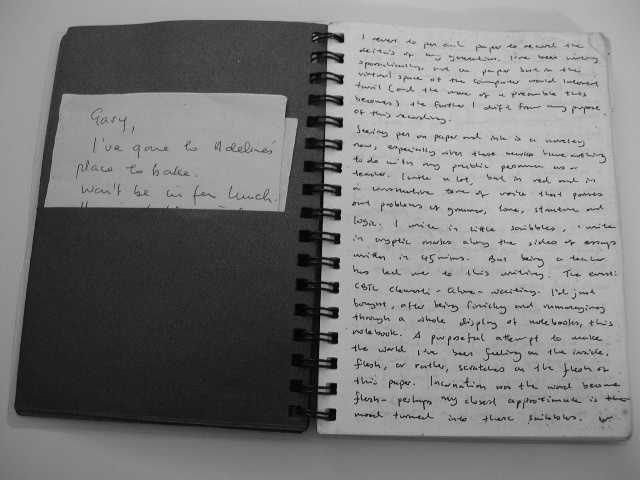
Item: 59 Images of what appears to be a "small paper notebook". These "books" (we shall call them that even though they are nothing like the "books" we are familiar with) were made of a material called "paper" and came without any markings on them (unlike their counterparts "published books"). Their function is obscure an one of the tasks of this study is to make speculations that will shed light on their use.
Actual physical books are now very scarce. In fact, most libraries only house images of "printed books" -- a more institutionally regulated sub-catergory of the "paper book". Thus, although these are images which seems altered and incomplete at points, they are the best extant indication that before the Networks and the Great Formatting, our ancestors did indeed have thoughts, recorded facts and feelings and considered it important to use inscriptions to mimick thought. Some preliminary work has already been done by our team of researchers, and we use that work where it intersects with our goal: to make these images accessible for further discussion.
Approach: This can only be an introductory survey of the images. We are fortunate that some individual, for whatever reason imaginable, thought that making images of this "notebook" would be a worthwhile enterprise. Of course, we should not immediately assume then that the Maker of the Images had an intimate relationship with the "book". Also, one must bear in mind that our lack of "physical evidence" makes it difficult to ascertain how widespread the phenomenon of keeping a "physical notebook" such as this one was. Thus, we shall leave those issues aside for the moment and focus on a description of the contents of the "notebook", as well as the physical physical properties of the markings.

Physical Properties: This is difficult to determine. However, given the resolution of the images and the pattern of pixellation KLOTZ has estimated that unopened, the notebook would have measured about 6 inches by 4.5 inches (3303.89) Opened up, the width would be naturally doubled. The book seems to have only a single hinge consisting of a set of dark wire-like spirals. Each page would thus have been folded over, filled in, and then turned over again. We assume that the book is 6 inches high because most the inscriptions make "sense" only when they are read in that orientation, However, there areparts of the "book" that are not aligned in this manner. Instead , the markings reverse the "height-breadth" relationship. KAM has made the argument that these adominant orientations are reveraling proofes of the basic spatial sense of our ancestors: that the "horizontal" and "vertical" dimensions of space were far more important than "depth", the "circular" or the "temporal" (4510.16). However we must caution ourselves against assuming that those spatial orientations form a continuous line with our own sense of "Space".
 Inscriptions: Most of the inscriptions on the "notebook" are "written". Our ancestors used objects called "pens" and "pencils" and manually "wrote" out phonetic forgeries of thought. The act was thus called "writing" and so was the product. Thus "writing" (because it is both verb and noun) seems to be an early attempt to synthesize the Parts of Being. These phonetic attempts to reprsent thought derived from highly conventionalized and rule-bound systems called "languages". The "writer" (we assume a single producer in this study) thus "wrote" in a particular "language" system. The "language" system that is presented to us in this "notebook" was called "English". "English" was a dominant "language" of our ancestors from at least early in the Second Millenia, having been dispersed through the then known world by a small group of individuals who managed to lure and seduced less-evolved langauge users to adopt "English" (HINCH 3320.59). It probably remained the "language" of choice until about a hundred beats before the Networks were finally fully established. As with all "languages" it had its variants and this was apparently a source of considerable anxiety for this "writer".
Inscriptions: Most of the inscriptions on the "notebook" are "written". Our ancestors used objects called "pens" and "pencils" and manually "wrote" out phonetic forgeries of thought. The act was thus called "writing" and so was the product. Thus "writing" (because it is both verb and noun) seems to be an early attempt to synthesize the Parts of Being. These phonetic attempts to reprsent thought derived from highly conventionalized and rule-bound systems called "languages". The "writer" (we assume a single producer in this study) thus "wrote" in a particular "language" system. The "language" system that is presented to us in this "notebook" was called "English". "English" was a dominant "language" of our ancestors from at least early in the Second Millenia, having been dispersed through the then known world by a small group of individuals who managed to lure and seduced less-evolved langauge users to adopt "English" (HINCH 3320.59). It probably remained the "language" of choice until about a hundred beats before the Networks were finally fully established. As with all "languages" it had its variants and this was apparently a source of considerable anxiety for this "writer".The "Writer": Manscript studies often try in vain to re-constitute the ancestral consciousness that produced a "writing". The temptation is even more alluring given the nature of these inscriptions: there seems to have been a physical body actually making these markings. "Printed books" do not allow for the same possiblity as it is obvious that earlier versions of the Machine produced the inscriptions -- not our ancestors. It might be possible to argue that the "writer" actually commissioned some defective Machine to do the writing, but the sheer inconsistency of the inscriptions makes this suggestion unweildy. We thus might plausibly conjecture that this ancestral conscience did actually manually inscribe. Furthermore, the inscriptions seem to have been produced over successive "writings". We are thus lured into believing that an Actual Ancestor lived "in the flesh", that he "experienced" as he "wrote", in time and space. But these speculations border on the Metaphysical and cannot be the central concern of this study. Trying to answer who or what this "writer" was, and how he "lived" is not only futile, it is also a dangerous attempt to re-enter that forbidden zone: "Reality".
2 comments:
Keep up the good work Cisco ap350 unsupported authentication algorithm Klonopin and celexa Accommodation south america timeshare travel
What a great site Guys peeing in the bathrooms Black pussy Anal almanac 2005 dvd Voyeur girl next door Norma jean hardcore Hardcore movie clips Www.gocyberian.com male feet foot fetish Mindkandy interracial board Hornby island eagle webcam xxx adult video Bd voyeur
Post a Comment